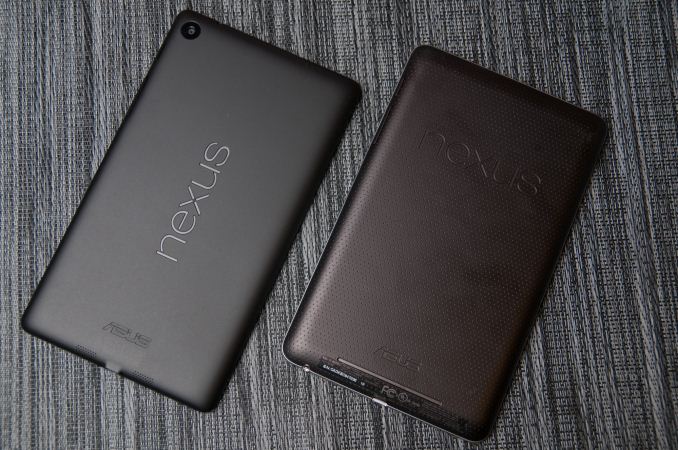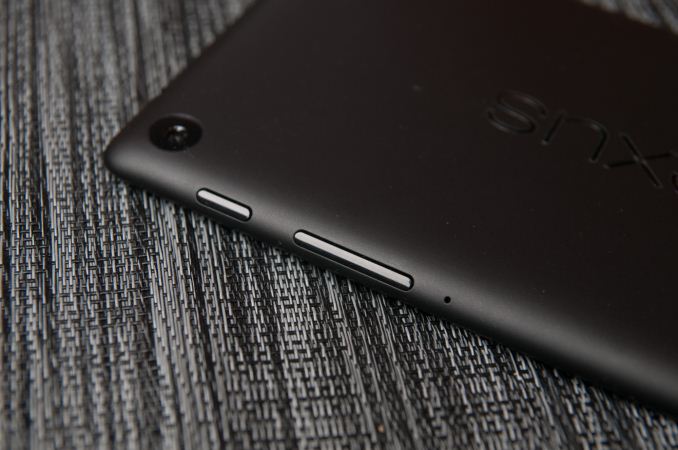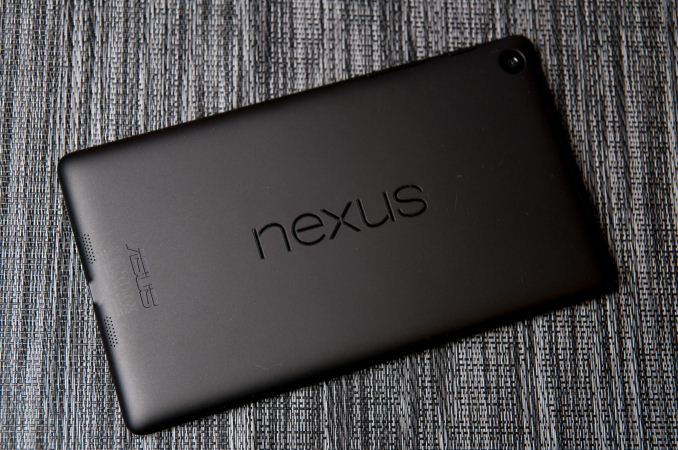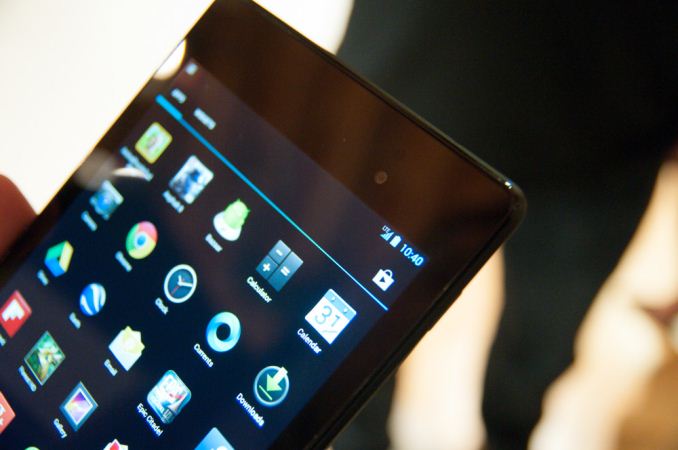Nexus 7 (2013) - Mini Review
by Brian Klug on July 27, 2013 12:54 AM EST- Posted in
- Tablets
- Snapdragon
- Qualcomm
- Android
- Mobile
- APQ8064
- Nexus 7
- Android 4.3

At an event in San Francisco, Google announced an updated version of the popular Nexus 7 tablet which first appeared at last year’s Google I/O. The big new features update the Nexus 7 platform with inclusion of a 1.5 GHz Snapdragon S4 Pro (APQ8064) SoC, 1920x1200 display by JDI (Japan Display Inc), as well as 5 MP rear facing camera, 1.2 MP front facing camera, stereo speakers, dual band WiFI, wireless charging (Qi) and a thinner and lighter chassis. It’s a major update that keeps the competitive price point that made the original Nexus 7 appealing (the lineup starts at $229 for the 16 GB model) while bringing numerous much-needed improvements that people have asked for.
First off, it’s shocking how much of a difference the change in thickness and weight makes. The new Nexus 7 feels considerably lighter and thinner in the hand than its older counterpart. Gone is the textured rubberized (almost driver glove-like) material on the back, in its place a flat, uniform soft touch material. There’s Nexus emblazoned in landscape on the rear, which is a bit puzzling next to the 90 degree rotated ASUS down below. It irritates my OCD sensibilities seeing the two logos inexplicably perpendicular and right next to each other, but I suppose Google thinks this helps emphasize how much the Nexus 7 and Android platform are really tablet-friendly now, with landscape view support throughout the core apps.
The rear facing camera is in the extreme top left, next to the power and volume rocker buttons, and top speaker. The Nexus 7 build and finish does feel a bit more plasticky to me this time around, but that’s almost expected given the price point, and it isn’t a major dig on the hardware at all. That’s not to say it isn’t sturdy or well put together, but just that the original Nexus 7 left a stronger impression on me last time, and I’ve been spoiled by the ASUS FonePad since then. The edge chamfer also helps the Nexus 7 feel a bit more like the Nexus 4 with its rounded edge. The previous Nexus 7 came to a point that could be a bit sharp at times.
What’s a little awkward is how tall the bezel at top and bottom looks on the Nexus 7, I’m warming up to it. On paper the new Nexus 7 is smaller in almost every dimension, in reality the elongated aspect ratio is definitely a bit pronounced here. There’s also still a notification LED well hidden under the glass at bottom in the center.
On the back is the new 5 MP rear facing camera, buttons (which hug the edges), a microphone port, and speakers. The speakers fire out the back of the Nexus 7 and look like they have good separation (obviously the best that the device’s size affords – top and bottom), but I don’t have a good feel for just how loud they go quite yet. Having stereo is a dramatic improvement for the audio part of video and multimedia consumption, and Android does 5.1 virtualization out the speakers as well. On the connectivity side of things there’s microUSB at the bottom with SlimPort video out, and a 3.5mm audio jack. I know a lot of people were hoping for inclusion of line in on the 3.5mm audio jack but I can confirm it isn’t present.
| Nexus 7Tablet Specification Comparison | ||||
| ASUS Nexus 7 (2012) | ASUS Nexus 7 (2013) | |||
| Dimensions | 198.5 x 120 x 10.45mm | 200 x 114 x 8.65mm | ||
| Chassis | Plastic + Rubber back | Plastic + Soft Touch back | ||
| Display | 7-inch 1280x800 IPS | 7.02-inch 1920x1200 IPS | ||
| Weight | 340 g | 290 grams (WiFi), 299 grams (LTE) | ||
| Processor | 1.3 GHz NVIDIA Tegra 3 (T30L - 4 x Cortex A9) | 1.5 GHz Qualcomm Snapdragon S4 Pro (APQ8064) | ||
| Memory | 1 GB | 2 GB DDR3L | ||
| Storage | 8 GB / 16 GB | 16 GB / 32 GB | ||
| Battery | 16 Whr | 15.01 Whr | ||
| WiFi/Connectivity | 802.11b/g/n, BT, NFC | 802.11a/b/g/n, BT 4.0, NFC | ||
| Camera | – |
5.0 MP Rear Facing w/AF 1.2MP Front Facing |
||
| Wireless Charging | – | Yes (Qi Compatible) | ||
| Pricing | $199/$249 |
$229/$269 (WiFi 16/32 GB) $349 (LTE) |
||
My only real complaint with the new Nexus 7’s in hand feel and build is with the power button and volume rocker, which feel somewhat mushy to me. I had issues taking screenshots even at times. It’s a minor gripe, but with only three buttons on the whole device, and generally good execution by ASUS with buttons on tablets, it surprised me. I guess I also do miss that racing glove-inspired texture in the soft touch on the back of the original Nexus 7.
| Nexus 7 (LTE) Band Coverage | |||||
| Model | GSM/EDGE Bands |
WCDMA Bands (HSPA+ 42) |
LTE Bands (UE Category 3) |
||
| North America Nexus 7 LTE |
Quad Band (850 / 900 / 1800 / 1900 MHz) |
HSPA+: 850/900/1900/2100/AWS(1700/2100) MHz (Bands: 1/2/4/5/8) | 700/750/850/1700/1900/2100 MHz (Bands: 1/2/4/5/13/17) | ||
| Europe Nexus 7 LTE | 800/850/1700/1800/1900/2100/2600 MHz (Bands: 1/2/3/4/5/7/20) | ||||
There’s a version of the Nexus 7 with 32 GB of storage and LTE onboard for $349 which will appear ‘in the coming weeks’ and includes support for AT&T, T-Mobile, and Verizon LTE in the USA on one piece of hardware. This is the first single SKU solution I’m aware of with coexistence of Bands 13 and 17 (Verizon and AT&T respectively) on the same device, which is awesome. There’s a model with Bands 3, 7, and 20 for Europe as well, so they’re not left out of the LTE fray. I had a chance to quickly get a look at the new Nexus 7 with LTE, which includes a microSIM tray and was working on one of the LTE networks in San Francisco just fine.
As far as I know, the Nexus 7 LTE solution is Qualcomm’s MDM9215 with a WTR1605L transceiver inside, and doesn’t necessarily include any of the new RF360 brand of front end hardware (like the power amplifier with integrated antenna switch or tunable front end), since MDM9x15 only works with QFE1320 (Bands 1,2,3/4,5,8,20). Still, that makes it all the more impressive, and Google deserves considerable kudos for further pushing such unprecedented interoperability, since in a tablet you do have more area to include discrete power amplifiers and filters.




















252 Comments
View All Comments
lordlad - Monday, July 29, 2013 - link
you are definitely entitled to your opinion (being freedom of speech and all) and i will be the first to agree with you if it's android v1 till v3.0. But since 4.0 ICS and above, many of the UI quirks had been ironed out at a rapid pace and android is still the most featured (functional wise) mobile OS out there.Which mobile OS currently allows you to access your home NAS and copy/paste file from/to your mobile device? Such a no-brainer use-case but IOS can't do it. Windows Phone 8 can't do it. I have no idea about BB10 so i can't comment but Android can do this among others. Most of the Mobile platform out there to me are more like appliances OS platform whereby the function of the OS and devices are defined by the makers and app-creators. It's like a vacuum cleaner can only do vacuum cleaning. An appliances.
Android, at least from my perspective, it's a mobile computing platform. The OS performed a certain functions but there's no pre-defined role of what it can do or can't. You can probably put android in a nuclear missile launching silo and it will probably worked (with some re-tooling of course).
All I'm saying is android is more akin to having a full computer in a phone/tablet form factor.....while else the other platforms (IOS, Windows Phone) are more like phone and tablet appliance. I'm sure their user experience, being much more curated, resulted in a 'tighter' experience...but it also resulted in a much more 'restricted' experience..
I must have pulled out a few hairs when i am trying to attach certain files to an email i am typing on my ipad. Such is the result of a constrained, 'appliance' experience..
but alas, to each his own. ;-)
akdj - Saturday, August 3, 2013 - link
Interesting take. Especially Android tablets in launching silos. Word is most of those were built in the 60s 70s and 80s...the power in any of today's tablets far surpasses what computing power was available when those missiles were deployed. So you're right...they very well COULD work as a missile launch and targeting system....that said, they'd get the app AFTER iOS does;). Already over a half million iPads have been deployed by major airlines across the world. Including updated Jep charts and plates, real time weather and traffic conditions, etc. They decided to go with iOS. Not Android. While I'm brand agnostic (I've got iOS and Android devices) and prefer not to trumpet my opinions on a board read and provided by folks many times smarter than me...your take on Android is a bit 'over the top' at this time. iOS is a simple to use device that many 'power' users won't find able to fulfill their needs...but many moms n dads and grandmas and gramps...kids as well....checking email and Facebook, posting n manipulation of stills and video, watching Netflix or Hulu...messaging and browsing, the things they ONLY used their old desktop or laptop for, it's an absolute answer to their needs. Android is a bit more tricky to learn, a bit different to set up and use, and its lack of optimized tablet apps is a killer.While the case can be made that Android COULD in fact be a better all around computing device, I guess we'll just have to wait for the developers to take notice and advantage of such an excellent subsystem.
We'll see. Until then....you're definitely entitled to your opinion, as you say...according to the constitution (though not all readers of Anand are from the USA)...however, you're wrong. Sorry
J
kascollet - Sunday, August 4, 2013 - link
I connect my iDevices to my NAS on a daily basis. Works perfectly over SMB and AFP. The app is FileBrowser but there are others to perform this use case. With my former Nexus 4, I couldn't do it as flawlessly, whatever the app I tried.Smartphoneuser - Wednesday, July 31, 2013 - link
This is flame bait. You are in the minority. I always ignore trolls, but could not resist the temptationfor2015nexus7 - Sunday, July 28, 2013 - link
this got to be the best tablet review site. anyways, how is the.speaker comparing to kindle fire hd in terms of loudness and clarity. thax a lot!andypost - Monday, July 29, 2013 - link
Asus Memo Pad 7" @ $90 might be a better value buy for a lot of folks.harishlj - Monday, July 29, 2013 - link
Brian's mini review is more detailed than most full-reviews done by others. Love the detailed run-down of the hardware and the features.geniekid - Monday, July 29, 2013 - link
I believe the popular opinion regarding the use of Snapdragon vs Tegra 4 was that the LTE capable version of the Tegra (the Tegra 4i) wasn't ready fast enough to meet the release schedule of the new Nexus 7.Bob Todd - Monday, July 29, 2013 - link
I'd say Tegra 4 not fully supporting OpenGL ES 3.0 is a bit of a problem when that's one of the marquee features of Android 4.3 which is debuting on this device...aliasfox - Monday, July 29, 2013 - link
To be fair, my 2010 iPad (with its single core processor and a whopping 256 MB of RAM) is already dog slow on iOS5, which I feel was built with the A5 chip in mind (iPhone 4s, iPad 2/3). iOS7 will likely be built with the A6 chip in mind, so with 1/2 the cores, 2/3 the clock speed, and 1/4 the RAM, an original iPad would be left breathless right at startup.As for the Nexus 2013, I like it a lot. My gf has the original Nexus, and while it's a fine product, it doesn't feel particularly premium. The new one looks to be nearly as thin and nearly as light as an iPad mini, but $100 cheaper. Even if Apple were to thoroughly update the mini (A6, retina display), this would still be very, very tempting to grab for a weekend getaway tablet.